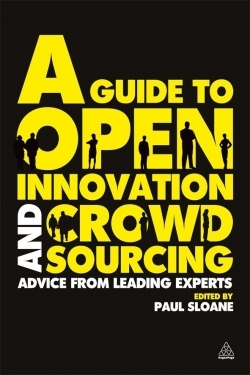A Guide to Open Innovation and Crowd Sourcing
Advice from Leading Experts
The social networking revolution has brought with it a related phenomenon–the active involvement of the public in commenting upon and sometimes even creating products and services. The result is a specific way of doing business known as “crowdsourcing” which, says Paul Sloane, means to offer “a challenge to a group of people that you may or may not know and solicit their ideas and solutions for your issue.” Crowdsourcing is part of a larger strategic way of thinking about business called “Open Innovation,” or OI.
This book is an essential guide to both Open Innovation and crowdsourcing, because it is a compilation of the best thinking by experts on both subjects. Editor Sloane has carefully selected pieces on both subjects and woven them together into a cohesive text. The book starts with in-depth definitions of Open Innovation and crowdsourcing. It then moves through over twenty individual essays that cover such topics as institutionalizing Open Innovation, understanding the leadership issues and challenges associated with Open Innovation, how to motivate crowds to participate, building a culture for Open Innovation and crowdsourcing, managing intellectual property issues, and common mistakes.
Because Open Innovation is an emerging concept, case studies of companies successfully implementing OI are essential. In this regard, Sloane’s book delivers. It includes a number of relevant stories, such as the manner in which LG Electronics applies innovation, and the way in which OI was introduced at Intuit. Also included is the story of Threadless.com, a wildly successful online t-shirt company that grew exclusively by co-creating products with its customers. Threadless is one of the companies credited with starting the crowdsourcing revolution.
While Open Innovation is still in its infancy, there are professionals who have already become accomplished in the field. The reader will find pieces in A Guide to Open Innovation and Crowdsourcing from “the father of Open Innovation,” Henry Chesbrough, as well as leading consultants and practitioners. Among the companies and institutions represented in the book are Accenture, the Innovation Management Institute, Intuit, Kraft Foods, LG Electronics, MIT, Nokia, University of California-Berkeley, and Unilever.
A Guide to Open Innovation and Crowdsourcing has a good mix of theoretical and practical material, so there is likely to be something of value for everyone, regardless of one’s specific interest or responsibility. Importantly, the book also offers a few entries that address the future of Open Innovation, suggesting that integration and commercialization will be critical to its success. Sloane’s recommended reading and references will be helpful to those individuals who want to delve further into OI.
Reviewed by
Barry Silverstein
Disclosure: This article is not an endorsement, but a review. The publisher of this book provided free copies of the book and paid a small fee to have their book reviewed by a professional reviewer. Foreword Reviews and Clarion Reviews make no guarantee that the publisher will receive a positive review. Foreword Magazine, Inc. is disclosing this in accordance with the Federal Trade Commission’s 16 CFR, Part 255.

